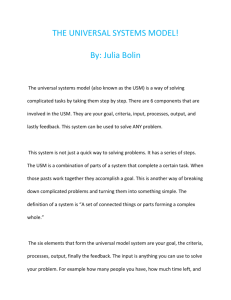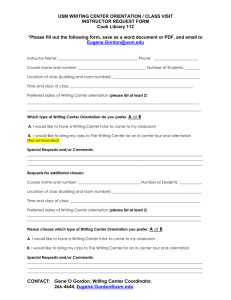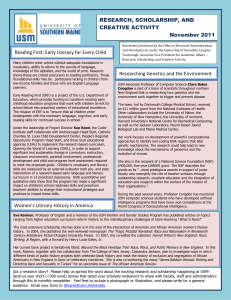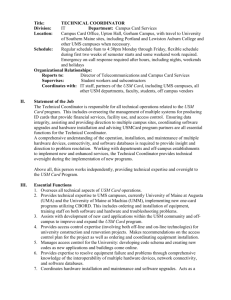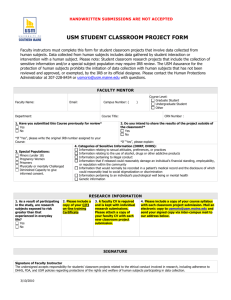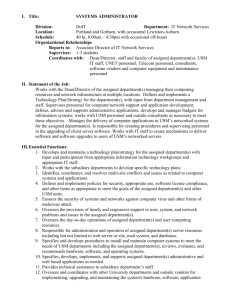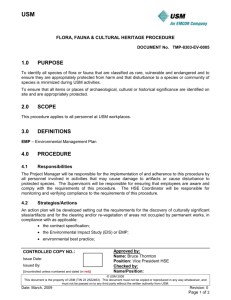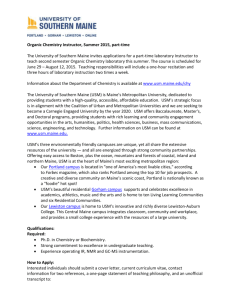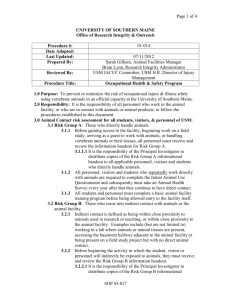USM Online Learning Strategic Plan
advertisement
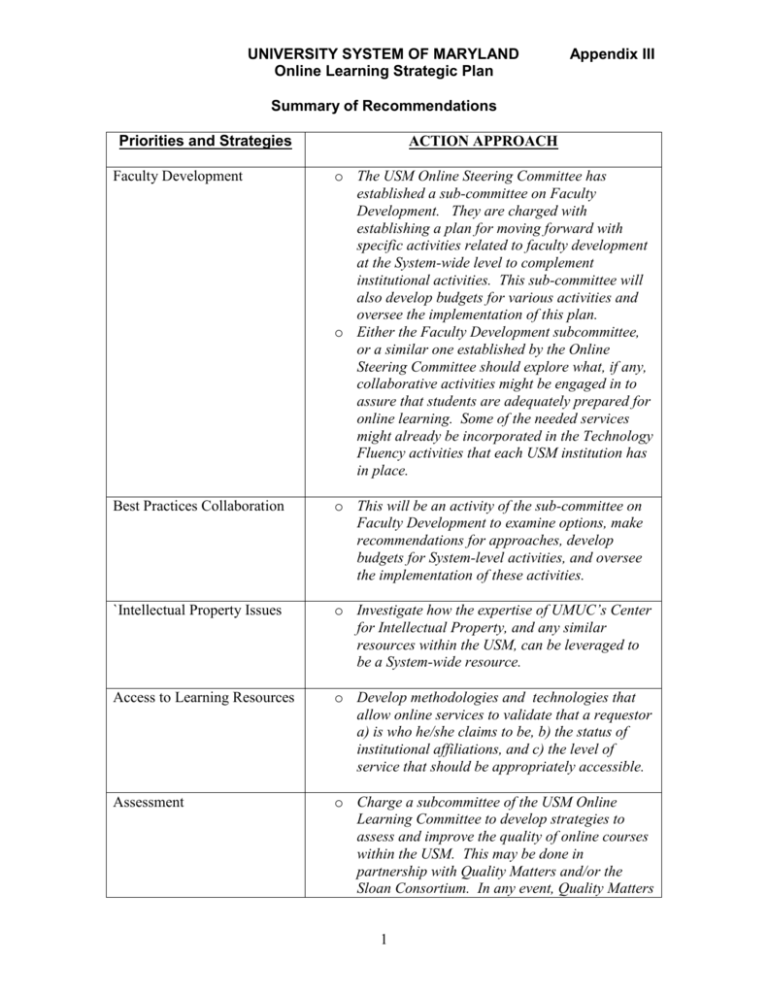
UNIVERSITY SYSTEM OF MARYLAND Online Learning Strategic Plan Appendix III Summary of Recommendations Priorities and Strategies ACTION APPROACH Faculty Development o The USM Online Steering Committee has established a sub-committee on Faculty Development. They are charged with establishing a plan for moving forward with specific activities related to faculty development at the System-wide level to complement institutional activities. This sub-committee will also develop budgets for various activities and oversee the implementation of this plan. o Either the Faculty Development subcommittee, or a similar one established by the Online Steering Committee should explore what, if any, collaborative activities might be engaged in to assure that students are adequately prepared for online learning. Some of the needed services might already be incorporated in the Technology Fluency activities that each USM institution has in place. Best Practices Collaboration o This will be an activity of the sub-committee on Faculty Development to examine options, make recommendations for approaches, develop budgets for System-level activities, and oversee the implementation of these activities. `Intellectual Property Issues o Investigate how the expertise of UMUC’s Center for Intellectual Property, and any similar resources within the USM, can be leveraged to be a System-wide resource. Access to Learning Resources o Develop methodologies and technologies that allow online services to validate that a requestor a) is who he/she claims to be, b) the status of institutional affiliations, and c) the level of service that should be appropriately accessible. Assessment o Charge a subcommittee of the USM Online Learning Committee to develop strategies to assess and improve the quality of online courses within the USM. This may be done in partnership with Quality Matters and/or the Sloan Consortium. In any event, Quality Matters 1 Innovation has established a rubric for such course assessment. o Charge a subcommittee of the USM Online Learning Committee to monitor and disseminate research in the area of learning effectiveness. o Charge a subcommittee of the Online Steering Committee to monitor best practices in student assessment and to develop techniques for disseminating this information across the USM. o Action Approach: Establish an on-going subcommittee that will investigate emerging technologies and technology trends that will have the possibility of improving both the classroom and network-based learning environments. This sub-committee shall keep the Online Steering Committee and the USM institutions informed of its findings. 2 University System of Maryland Online Learning Strategic Plan Background Each University System of Maryland (USM) institution has created a strategic plan to enhance its offerings of online learning opportunities to students1. During the past year, by and large these institutions have moved with some dispatch to put these plans into action.2 What, a few years ago, was largely the province of a single USM institution has now become a broad trend to provide improved student access to learning opportunities. While UMUC continues to be an international leader in online learning, other USM institutions have undertaken notable initiatives in selected areas. The USM is charged by the Board of Regents to establish a System-wide plan that complements and supports the various institutional plans. This System-wide plan has been developed and implementation will be overseen by the USM Online Steering Committee. Priorities and Strategies While there are numerous possibilities for System-wide action to support individual campus plans, the Online Steering Committee has identified six primary areas where initial efforts should be directed. These are: Faculty Development and associated Student Readiness Assessment and Training; Collaboration on Best Practices; Addressing Intellectual Property Issues; Access to Learning Resources; Assessment (in its many interpretations), and Innovation. We will examine these one by one and outline strategies for approaching these areas. Faculty Development By and large, faculty support and training is a campus based activity. Much of the training is specific to the campus environment and the Course Management System being used locally. Still, the USM institutions are uneven in their ability to provide training for faculty-----some have limited capabilities, while others have mature programs. An immediate task will be to understand how institutions will be able to level out training capabilities. “Training” in the use of technology and related issues is perceived as different from “faculty development.” Pedagogy in an online environment is significantly different from classroom pedagogy. In the classroom response is immediate, either by visual cues or by student questions. Online, one has to design materials in such a way that students can be more self-reliant in understanding the information. Class interactions in the online environment might in fact be more extensive than in the classroom, but again the teacher has to learn how to guide discussions not be the focus of all questions---otherwise he or she will be overwhelmed. Finally, without the regularly scheduled classroom time, 1 2 See Appendix 1 for a summary of these plans. See Appendix 2 for a comparative chart 3 teachers have to create an environment where students can stay engaged and motivated in a more self-paced approach. The USM has great strengths regarding insights into online pedagogy. Again, these are not evenly distributed among USM institutions. Thus one System-wide service would be to establish vehicles for taking advantage of the internal strengths in this area to the benefit of faculty at all USM institutions. These vehicles could include workshops, both online and face to face, conferences, self-paced online content, FAQs and discussion fora, summer camps, etc. o Action Approach: The USM Online Steering Committee has established a subcommittee on Faculty Development. They are charged with establishing a plan for moving forward with specific activities related to faculty development at the System-wide level to complement institutional activities. This sub-committee will also develop budgets for various activities oversee the implementation of this plan. o Action Approach: Either the Faculty Development subcommittee, or a similar one established by the Online Steering Committee should explore what, if any, collaborative activities might be engaged in to assure students are adequately prepared for online learning. Some of the needed services might already be incorporated in the Technology Fluency activities that each USM institution already has in place. Best Practices Collaboration While Faculty Development efforts are broadly directed toward USM faculty members, it is recognized that different disciplines have different pedagogical styles and learners have different learning needs. Thus a strategy to support teaching and learning in a new medium needs to also take a finer granularity approach. This is conceived as being a strategy to determine and inform the community regarding best practices----most likely discipline by discipline. There may be some areas that cut across multiple disciplines, e.g. how to handle laboratory sessions in an online course. One strategy that has been discussed would be to facilitate self-sustaining learning communities of faculty working on similar pedagogical issues. Since it may be often the case that a critical mass of such faculty may not exist at any one USM institution, this is a natural role for a System-wide approach that would transcend institutional boundaries. o Action Approach: Again, this will be an activity of the sub-committee on Faculty Development to examine options, make recommendations for approaches, develop budgets for System-level activities, and oversee the implementation of these activities. Intellectual Property Issues The Intellectual Property (IP) issues surrounding online learning are complex and can be viewed differently from various perspectives. Content material in digital form is much 4 more flexible, and can be handled in a much more flexible manner, than content in traditional paper, audio, video formats. Digital information can be copied, modified, distributed, and redistributed often with ease. Thus there are IP issues related to control and economics that are inextricably tied to digital materials, especially those accessible via the Internet. Since online course content can be easily shared and/or reused, there are two basic issues at play: ‘who owns the content’? and ‘what content can be used by faculty in developing a course?’ . The issue related to ownership is covered under the USM Policy on Intellectual Property3. As it affects this issue, it says that ownership policies for ‘Technology Mediated Instructional Materials,’ with some exceptions, will be determined on an institution by institution basis. Thus this is not an issue for this strategy discussion. The issue related to faculty use of content that may have been created by others, however, is a knotty matter that each faculty member, and thus each institution, will need to deal with carefully. This brings faculty and institutions into contact with existing copyright law, and introduces both opportunities and risks. For each USM faculty member and/or institution to have to resolve these matters separately and individually is both inefficient and likely to be inadequate to the need. Fortunately the USM has a unique resource, the UMUC Center for Intellectual Property (www.umuc.edu/cip), which has expertise in these matters. o Action Approach: Investigate how the expertise of UMUC’s Center for Intellectual Property, and any similar resources within the USM, can be leveraged to be a System-wide resource. Access to Learning Resources Higher Education has well developed mechanisms to provide materials that support teaching and learning in traditional modalities: libraries, reserve materials, book stores, invited lectures, etc. In an online teaching and learning environment, one cannot assume that these same resources will be easily accessible since it is possible that neither the student nor the faculty member will ever be physically present on a campus. Thus other mechanisms must be developed to support teaching and learning, many of which will be digital and online. The campus based services are traditionally focused on an individual campus community, since that community is geographically co-located. Most electronic services are similarly internally focused campus by campus in the USM. Thus questions such as ‘who is a member of the community being serviced?’ or ‘how do we validate that someone should have access to a particular service’ tends to be answered differently and separately be each campus. There are some services that have transcended this model: e.g. there is a single Library Information Management System (LIMS) for the USM4. Due to the inward facing technology services of the individual institutions, LIMS is forced to answer the above questions by creating yet another database of known patrons. 3 4 Cf http://www.usmd.edu/Leadership/BoardOfRegents/Bylaws/SectionIV/IV320.html and in fact this system includes the libraries of Morgan State University and St. Mary’s College 5 This is created and managed internal to LIMS and patrons are forced to physically visit a library in order to become ‘known’. This model is both inefficient and impractical as a way to support online learning, where many such services may need to be created while students and/or faculty may never come to a campus and in fact, a student or faculty member may have affiliations that cross institutional boundaries. o Action Approach: Develop methodologies and technologies that allow online services to validate that a requestor a) is who he/she claims to be, b) the status of institutional affiliations, c) the level of service that should be appropriately accessible. Assessment “Assessment” comes into play at many levels in the online learning process. Many of these interpretations are common across institutions, and in many instances, a collaborative study or solution may assist individual faculty or institutions. o There are often questions regarding the quality of an online course---perhaps in comparison with comparable online courses or with classroom-based courses. These questions could be answered in part by some type of class assessment methodology. o Another interpretation of “assessment” is in the context of learning effectiveness and learning outcomes assessment. Do students in online courses learn what is expected; as well as in classroom learning environments; etc.?. o Finally, there are questions of “student assessment” when one never comes in direct contact with the student. How is the instructor assured of academic integrity in these circumstances? Many of these are issues of on-going research and not easily answered. However, there is likely benefit in monitoring this research in a collective fashion where there can be knowledge sharing across institutions rather than force each institution to track these issues individually. Additionally, UMUC has an Assessment Resource Center (http://www.umuc.edu/distance/odell/irahe/arc/archome.html) that could be leveraged into a USM resource. As regards assessment of course quality, the Fund for the Improvement of Postsecondary Education (FIPSE) has funded a project, Quality Matters (www.qualitymatters.org), hosted by Maryland Online. Additionally, the Sloan Consortium has on-going activities to help improve the quality of online courses. Action Approach: Charge a subcommittee of the USM Online Learning Committee to develop strategies to assess and improve the quality of online courses within the USM. This may be done in partnership with Quality Matters and/or the Sloan Consortium. In any event, Quality Matters has established a rubric for such course assessment. Learning effectiveness is one of the ‘five pillars’ of online learning upon which the Sloan Consortium is focused. They have an effective practices initiative in this area. 6 (Summaries can be accessed at http://www.sloan-c.org/effective/index.asp ). Additionally, there is a substantial amount of other research in this area. Action Approach: Charge a subcommittee of the USM Online Learning Committee monitor and disseminate research in the area of learning effectiveness. There is a substantial literature regarding effective student assessment in online courses. The primary issue is one of analyzing the literature and disseminating best practices. Action Approach: Charge a subcommittee of the Online Steering Committee to monitor best practices in student assessment and to develop techniques for disseminating this information across the USM. Innovation Web based asynchronous online learning is only one modality for improving access, effectiveness, and/or efficiency of teacher/student interaction by use of technology. It is but the current instantiation of a long progression of iterations of technology enhancing the learning environment. By focusing entirely on this current view, it is recognized that USM institutions may be slow to recognize and adopt the next iteration. For example, classroom based learning is being moved also outside of the classroom by the use of podcasts. Similarly, there are several technologies that not only record lectures and classroom interactions for review subsequently, but also allow indexing of individual student notes to correlate with a lecture on demand. Distance education via asynchronous online learning can be complemented by synchronous distributed lectures and classroom discussions. Thus, in the interest of looking ahead and keeping our learning environments aware and capable of taking advantage of emerging instructional and learning support technologies, the Online Steering Committee recommends that there be a standing sub-committee to investigate, and propagate awareness of emerging educational technologies. Action Approach: Establish an on-going sub-committee that will investigate emerging technologies and technology trends that will have the possibility of improving both the classroom and network based learning environments. This sub-committee shall keep the Online Steering Committee and the USM institutions informed of its findings. 7 Appendix 1 INSTITUTIONAL STRATEGIES AND KEY ACTIONS BSU Develop a BS in Technology fully online program in the School of Business Investigate offering an MS in Information Systems program fully online The School of Education is engaged in an initiative to develop additional online courses for the MAT program Increase the number of fully online and hybrid courses and supplement traditional courses CSU Enhance online and hybid offerings for required General Education courses with the goal of having all courses available either online or face-to-face Increase online and hybrid courses in the M.Ed., Management Science and Economics, Nursing, and English programs Identify additional existing academic programs for online development Explore the potential for offering online winter and summer courses FSU Increase the number of fully online courses offered during the summer and Intersession terms. During the 2005 Intersession (January), FSU enrolled 261 students in 21 online course sections. In the summer of 2005, FSU offered 51 course sections, enrolling a total of 514 students. Use FSU online education fully at the University System of Maryland at Hagerstown Offer more online courses during the regular academic terms. Develop online courses specifically for the BTPS programs in Criminal Justice, Health Science Administration, and Information Technology Management Add hybrid (blended) courses to the FSU curriculum Explore creating blended and online versions of an existing FSU graduate program SU Initiate a Soaring with Distance Education Program, offering online courses developed in the program in summer 2005 Creation of training program for Faculty who are developing on-line courses. Twenty faculty have completed the program to date with over 40 course sections offered in 2005 Drafting of a formal policy describing the procedure for offering online courses (to be approved this semester) Creation of An Ad Hoc Committee on Online Learning appointed by the Provost Leverage the success of Summer 2005 offerings and Sloan participation Active discussion on campus about targeting specific general education courses for delivery on line 8 Review of the student services provided and needed for online learners. TU Offer fully online courses as well as select fully online degree and/or certificate programs Implementing a pilot program to get four graduate programs and one undergraduate program fully online for fall 2006 o MS in Integrated Homeland Security, with a post-baccalaureate certificate in Risk Assessment and Management (Interdisciplinary Program housed in Towson's College of Graduate Studies and Research) o Graduate Certificate in Graphics Design (Department of Art, College of Fine Arts and Communication) o MS in Applied Information Technology (Center for Applied Information Technology, and Department of Computer Science, Fisher College of Science and Mathematics) o MS in Human Resource Development (Department of Family Studies, College of Liberal Arts) o BTPS in Allied Health (Interdisciplinary Program housed in Towson's College of Health Professions). Working committees have been established in the relevant colleges under the leadership of the respective deans, and a development fund has been established centrally to support these initiatives Enhance existing traditional courses and offer more hybrid courses Evaluate courses in high demand to determine the viability of optional online learning versions Offer outreach programs both for credit and noncredit as part of meeting workforce needs. UB Strive to be a leader among traditional institutions in the development of online programs, such as webMBA, and in the implementation of e-learning across the curriculum. UB offers the following fully online degree programs: BS in Business Administration (webBachelors), MBA (webMBA) and MPA (webMPA) Expand the national and global reach of UB’s academic programs through online instruction Enrich classroom-based instruction through creative uses of instructional technology Expand online instructional tools to include videostreaming and other multi-media for both synchronous and asynchronous distance education UMB Increase the level of fully online courses at the School of Nursing Use online learning as a foundation for some totally online programs at the School of Nursing such as the RN to BSN and masters degrees as well as post masters certificate programs Supplement traditional classroom courses with online learning technology for other professional education programs 9 UMBC Increase the number of fully online courses, in specific programs, especially courses in professional masters programs Offer increased opportunities for students to take courses outside of the normal two residential semesters, attracting new non-residential students as well as improving time-to-degree. Additional faculty will be need to add courses to teach additional students Increase the number of hybrid courses that provide students a mix of face-to-face and online experiences, moving a part of the “seat time” outside the classroom UMCP Target courses that might be suitable for partial or fully online instruction, providing increased course accessibility to students Provide instructional improvement grants for faculty, particularly in targeted areas to design courses Build in a reward system for online instructional innovation, with an incentive structure, such as expansion of the OIT program “Teaching with Technology.” Augment the current Undergraduate Research Assistant Program (URAP) for students interested in research experience to link students who have web expertise with faculty who need help with technology Promote standardization in both policy and tools across campus UMES Create a Department of Instructional Technology to aid in the development and support of fully online courses Planning on offering fully online courses during the summer and winter terms to UMES matriculated students Add hybrid courses to the curricula Use instructional technology to enhance traditional classroom courses UMUC UMUC intends to continue to distinguish itself as the leader in delivering quality online education to students anywhere in the world. As such, online learning at a distance has been, and is expected to continue to be, a strategic direction for UMUC UMUC has experienced a 1,322% increase in growth of enrollments in online courses over eight years UMUC’s online degree and certificate portfolio includes: 19 majors, 24 minors, and 23 certificates in the School for Undergraduate Studies; 17 masters degree programs with 22 specialty tracks, 9 dual degree majors, and 41 certificates in the Graduate School of Management and Technology In FY 2005, UMUC’s stateside and overseas online enrollments totaled 143,544 10 Appendix 2 Online Learning - Strategic Directions 2006 SUMMER AND WINTER SESSIONS INCREASE OR BEGIN OFFERING FULLY ONLINE COURSES DURING THE SUMMER AND WINTER SESSIONS PERVASIVE FULLY ONLINE COURSE OFFERINGS University of Maryland University College University of Baltimore Coppin State University Bowie State University Frostburg State University Salisbury University University of Maryland, Baltimore (School of Nursing) University of Maryland, Baltimore County University of Maryland Eastern Shore SUPPLEMENTARY ONLINE EDUCATION IS STRATEGIC TO THE INSTITUTIONAL MISSION SELECTIVE PROGRAMS INCREASE THE NUMBER OF HYBRID COURSES AS WELL AS SUPPLEMENT TRADITIONAL COURSES WITH ONLINE COURSE MATERIALS EXPLORE OR CONTINUE OFFERING FULLY OR MOSTLY ONLINE COURSES FOR SELECTIVE ACADEMIC PROGRAMS Bowie State University Coppin State University Frostburg State University Salisbury University Towson University All 11 degree-granting USM universities University of Maryland, Baltimore (Nursing, Social Work, Pharmacy, Dental) University of Maryland, Baltimore County (professional masters) University of Maryland, College Park (graduate programs) 11 12
